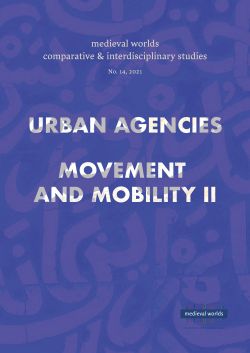Teresa Shawcross
S. 35 - 52
doi:
10.1553/medievalworlds_no14_2021s35
Verlag der Österreichischen Akademie der Wissenschaften
doi:
10.1553/medievalworlds_no14_2021s35
Abstract:
Chrysobulls issued »in common« to the inhabitants of cities, together with a large number of other surviving sources, shed light on the interplay in the Byzantine Empire during the long thirteenth century between, on the one hand, growing claims to civic autonomy advanced by communes and, on the other, efforts by imperial authority to control its territory. This chapter examines the emergence of a new kind of empire – based on commerce and trade – under the Palaiologoi. It analyses the changing circumstances of urban centres in the western provinces, and assesses the degree of fiscal, legal and political emancipation that these centres achieved. It discusses the creation of leagues and other types of alliances that successfully bound cities and towns together into regional associations. It also considers the mechanisms behind revolts and other forms of armed and unarmed protest that occurred against the central regime. Particular attention is paid to the region of northern Greece (Thrace and Macedonia) dominated by the city of Thessalonike, for which the evidence is most plentiful.
Late Middle Ages (13th-14th centuries), Palaiologan dynasty, Byzantine Empire, Greece, Mediterranean, urban history, global history, maritime trade, liberty/freedom, charters/ chrysobulls
Published Online:
2021/12/01 10:43:49
Object Identifier:
0xc1aa5576 0x003d0806
Rights:All rights reserved.For questions regarding copyright and copies please contact us by email.
medieval worlds provides a forum for comparative, interdisciplinary and transcultural studies of the Middle Ages. Its aim is to overcome disciplinary boundaries, regional limits and national research traditions in Medieval Studies, to open up new spaces for discussion, and to help developing global perspectives. We focus on the period from c. 400 to 1500 CE but do not stick to rigid periodization.
medieval worlds is open to submissions of broadly comparative studies and matters of global interest, whether in single articles, companion papers, smaller clusters, or special issues on a subject of global/comparative history. We particularly invite studies of wide-ranging connectivity or comparison between different world regions.
Apart from research articles, medieval worlds publishes ongoing debates and project and conference reports on comparative medieval research.
Urban Agencies: Reframing Anatolian and Caucasian Cities (13th-14th Centuries)
Guest Editors: Bruno de Nicola and Matthew Kinloch
Preface
Matthew Kinloch and Bruno de Nicola
Reframing Medieval Anatolia, Caucasia, and the Aegean: Narratives, States, and Cities
Matthew Kinloch
Urban Agency and the City Notables of Medieval Anatolia
A. C. S. Peacock
Cities and Imperial Authority in the Western Provinces of the Byzantine Empire, 12th-14th Centuries
Teresa Shawcross
A Conceptual Account of Market Morals that Resonated in Medieval Anatolia under Christian and Muslim Rule
İklil Selçuk
Merchant Capital, Taxation and Urbanisation. The City of Ani in the Global Long Thirteenth Century
Nicholas S. M. Matheou
Looking for Urban Agency in a City of Memorials: Tomb Towers of Late-Thirteenth-Century Ahlat
Oya Pancaroğlu
Urban Agency in the Borderlands: Turkmen Rulers and Administrative Elites in 13th-century Kastamonu
Bruno De Nicola
“These are the narratives of bygone years”: Conquest of a Fortress as a Source of Legitimacy
Dimitri Korobeinikov
Movement and Mobility in the Medieval Mediterranean:
Changing Perspectives from Late Antiquity to the Long-Twelfth Century, II
Guest Editors: Christopher Heath, Clemens Gantner and Edoardo Manarini
The Sicilian Tithe Business: State and Merchants in the Eleventh-Century Islamic Mediterranean
Lorenzo M. Bondioli
"Eager to Go to the Desert": Ambiguous Views on Ascetic Women’s Holy Travels in Late Antiquity
Andra Jugănaru
Where the Long Way Ends: Descriptions of the Mediterranean Sea and Holy Land and the Criticism of Crusading at the Court of Henry II of England (1154-1189)
Fabrizio de Falco
Individual Articles
"I am a virgin woman and a virgin woman’s child". Critical Plant Theory and the Maiden Mother Conceit in Early Medieval Riddles
Alaric Hall and Shamira A. Meghani
Latin and Hebrew Analogues to The Old Norse Leek Riddle
Alaric Hall




 Home
Home Print
Print
 References
References
 Share
Share
